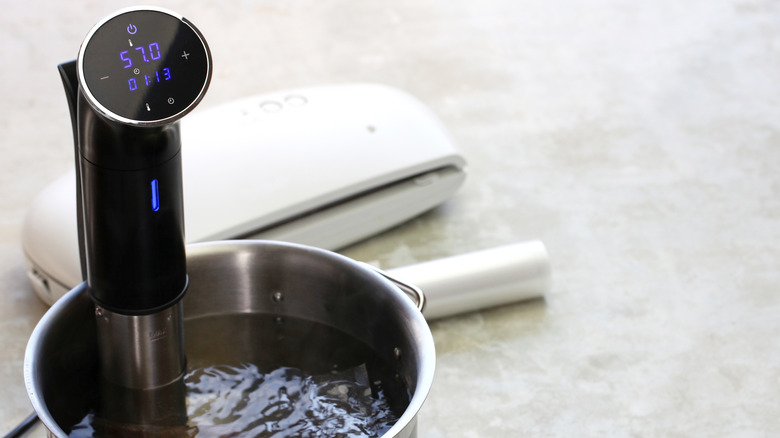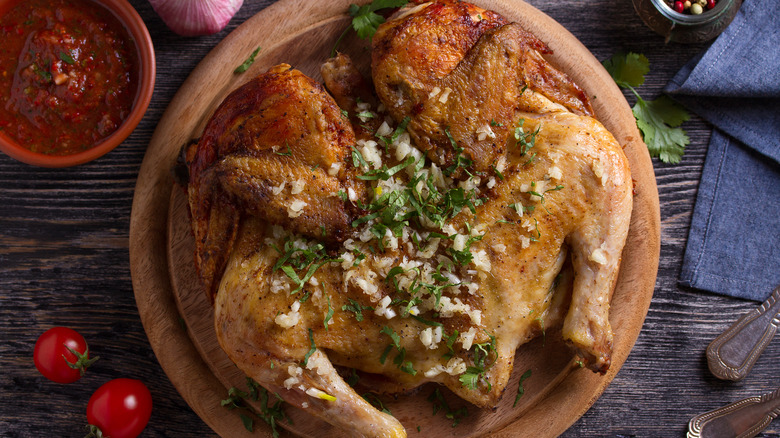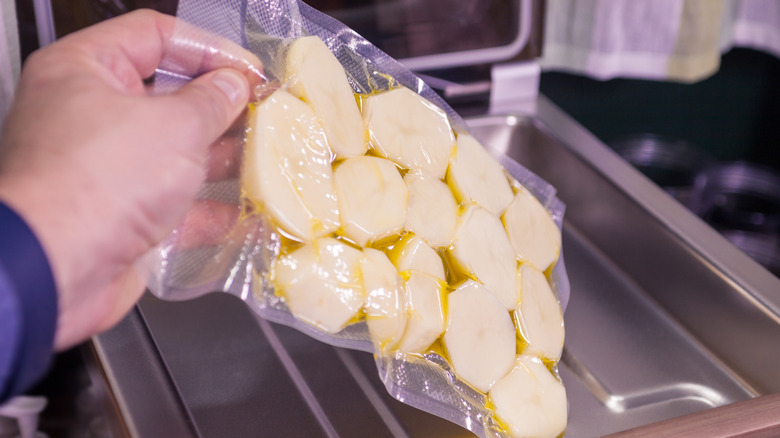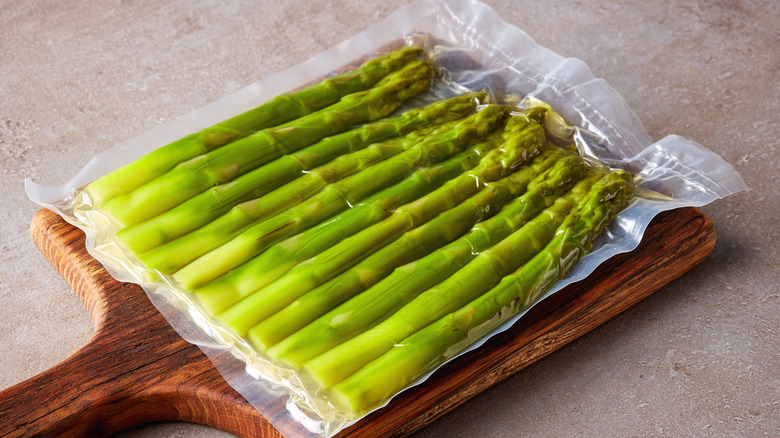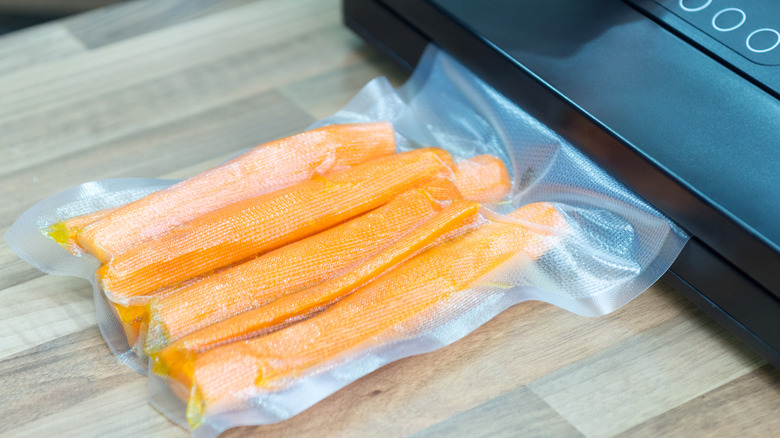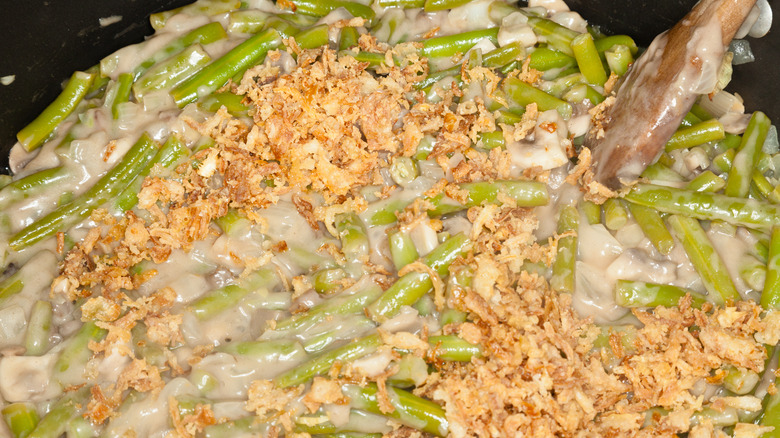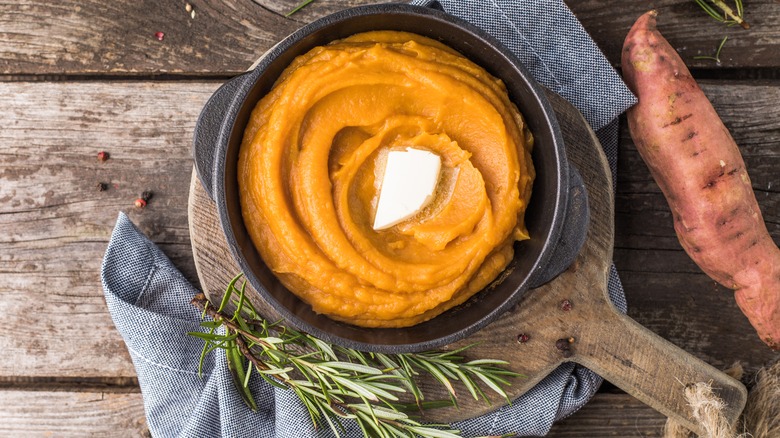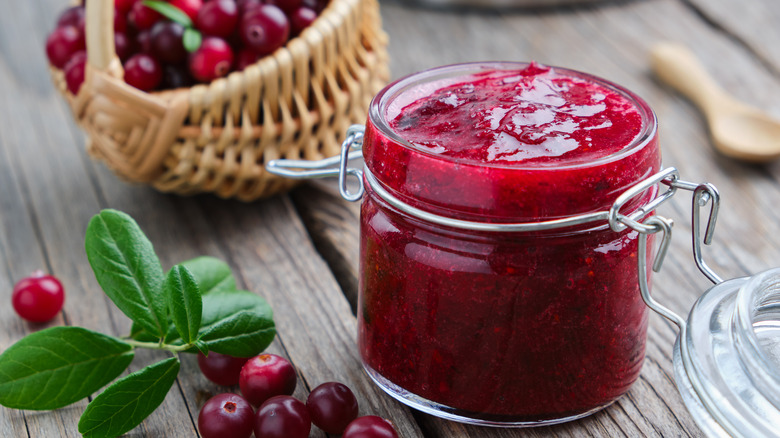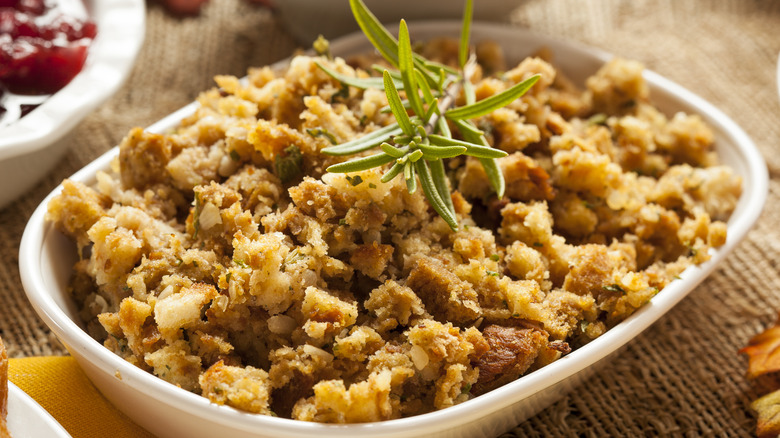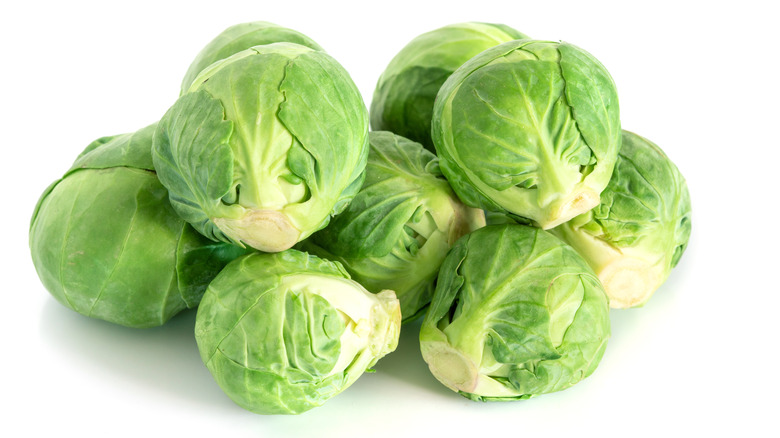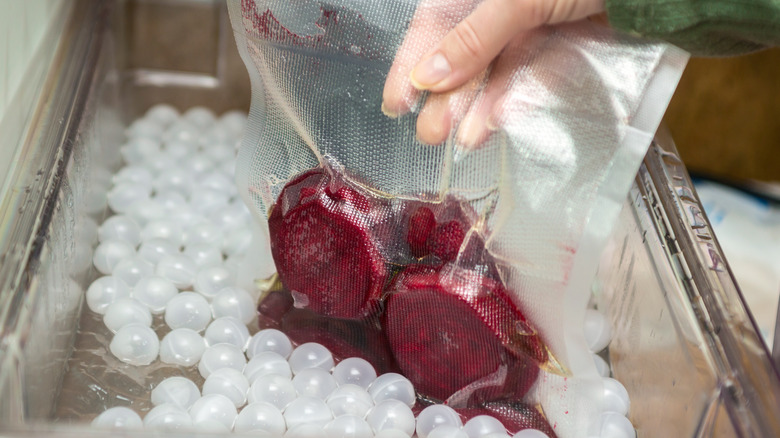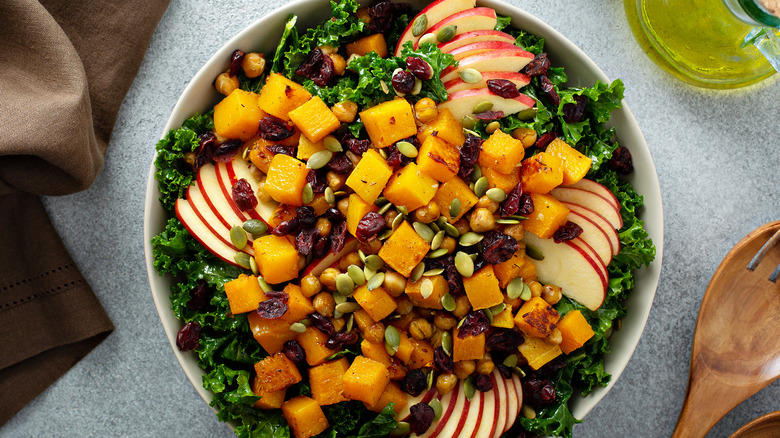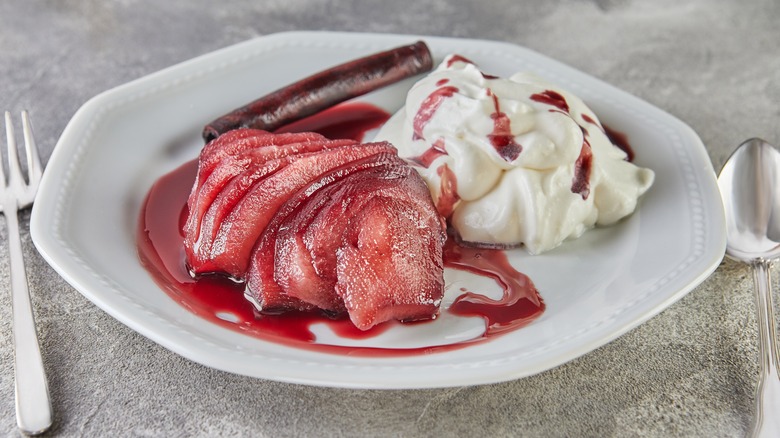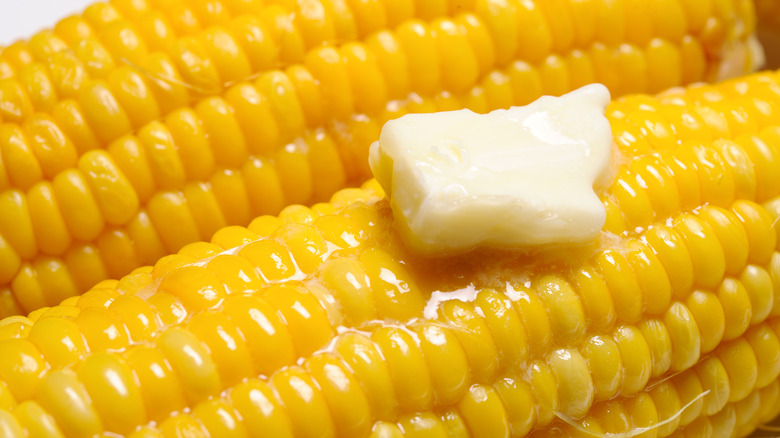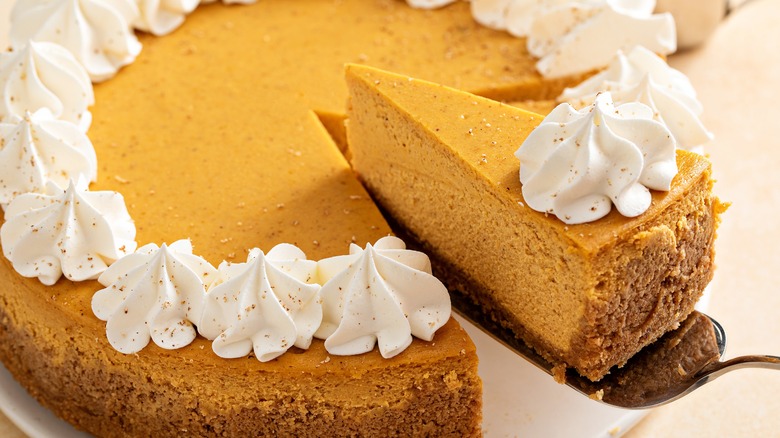16 Sous Vide Dishes You Can Make For Thanksgiving
Once the exclusive domain of Iron Chef and various food competition TV shows, sous vide is now a popular home-cooking technique that involves vacuum-sealing food in a plastic bag and place that bag in a hot water bath set to maintain a specific temperature. This low, slow, and direct-heat approach to cooking food can do amazing things in the form of sous vide eggs, salmon, or steak.
Sous vide is a pretty versatile technique that can be used to make an entire Thanksgiving dinner. Before diving into that topic, it's important to mention a couple of mistakes everyone makes with sous vide. First of all, it's important to make sure your bags remain fully submerged. Any bit of food sticking out above the water bath will be cooked differently from the rest. It's also important to keep your eye on the clock. Although the low heat of sous vides means it's difficult to overcook a dish, leaving something in the water bath too long could result in an undesirable texture.
While you probably won't use sous vide to cook your entire Thanksgiving dinner, it can help you reduce the burden on your oven. The technique also gives you valuable leeway during a hectic day of cooking.
Cook a perfect turkey
Cooking turkey sous vide might sound like a gimmick, but it just might be one of the better ways to prepare your bird. Sous vide foods are known to retain moisture, ensuring there won't be a single dried-out piece of your bird. Before even thinking about it, though, you should check to see if you can find sous vide bags and a water bath that is big enough to hold the turkey.
We recommend spatchcocking your turkey as a key first step. You could cook it whole for a more traditional presentation, but because the inside of the bird won't make contact with the water bath, you would need to fill your bag with a cooking liquid. If you've never had to spatchcock a turkey for Thanksgiving before, it's quite easy. Simply cut along both sides of the turkey's backbone and remove it. Press on the breastbone to flatten out the bird.
Brine your Thanksgiving turkey overnight before placing it along with some herbs into your bag, and then place the bag into your water bath. After cooking the bird with sous vide, you still have a bit more cooking to do in order to get the outside the right texture and golden-brown color. After removing the turkey from the bag and patting it dry, baste the bird with cooking oil and roast it at 500 degrees Fahrenheit until it is golden brown.
Get the creamiest mashed potatoes
The standard way to cook mashed potatoes on Thanksgiving is the boil the potatoes first. Boiling is a pretty easy way to cook, but it can strip away some flavor and nutrients from whatever you're cooking, including potatoes. If you cook your mashed potatoes sous vide, it preserves everything great about potatoes, allowing the root vegetables to absorb the flavors of whatever you place in the bag.
Our recipe for sous vide mashed potatoes calls for russet potatoes that are first washed, peeled, and cut into ¼-inch slices. The potatoes are then placed into the bag with potatoes, rosemary, garlic, cream, milk, butter, and salt. After 60 to 90 minutes at 194 degrees F, the potatoes are ready to be mashed and lightly cooked in their own liquid until you reach the desired texture. The superior flavors and texture of these potatoes are best enjoyed right away, but you could always make them up to five days ahead of time.
Asparagus and sous vide are a match made in heaven
Asparagus might not be on the top of your list regarding Thanksgiving sides, but it is one of the absolute best foods to cook sous vide. Unlike roasting, sous vide cooking produces firm and juicy stalks that aren't wilted. Sous vide also retains some flavor that would be lost with boiling. Steaming is a great way to cook asparagus, but sous vide is much more forgiving.
Start preparing your asparagus as you normally would by breaking off any thick woody ends and seasoning it with salt and pepper. Some recipes call for adding a bit of fat to the bag in the form of olive oil or butter. With the sous vide bath set at about 167 degrees F (75 degrees C), it only requires 10 to 15 minutes of cooking time. Before opening your bag, check to see if your asparagus is cooked to your liking by checking the texture at the base of the vegetables. If your asparagus is cooked properly and you are making this dish ahead of time, place the bag in a bath of ice water to halt the cooking process.
Sous vide glazed carrots are an easy win
In 2009, celebrity chef Daniel Patterson claimed in the Financial Times that "carrots are the new caviar." Patterson argued that if you start with premium carrots and prepare them with expert technique, you can produce something on par with dishes made from luxurious ingredients. A decade later, prominent chef Jeremy Fox took this idea to its logical extreme and created an entire tasting menu based on carrots.
We're not going to suggest you present a dinner of carrots for Thanksgiving, but cooking glazed carrots with the help of sous vide can bring a soft breeze of rarified air to your holiday meal. Select a mix of high-quality carrots, including some colorful heirloom varieties. The typical sous vide recipe will call for adding butter and herbs such as sage or thyme to the vacuum bag before sealing and cooking for one hour at 183 degrees F.
Take green bean casserole up a level (or two)
Green bean casserole may be a classic Thanksgiving side dish, but with the main ingredient being processed cream of mushroom soup, it doesn't exactly feel like a dish that was passed around at the first shared dinner. In fact, green bean casserole was invented at Campbell's in the 1950s by Dorcas Reilly, a supervisor in the test kitchen.
Sous vide cooking is a great way to get the perfect texture on your fresh green beans. Simply add your traditional ingredients to a vacuum bag, minus the crispy onions. Seal the bag and place it in a water bath for about two hours. To serve, empty the contents of the bag into a serving dish and top it with crispy onions.
If you want to take your side dish up another level, you should use Alton Brown's secret ingredient for green bean casserole: homemade cream of mushroom soup. The cream of mushroom soup recipe over at Mashed calls for butter, flour, celery, red onion, baby bella mushrooms, thyme, bay leaves, vegetable broth, and heavy cream. Be sure you don't skimp on the heavy cream when making mushroom soup from scratch, as you'll want that soup that is velvety and ready to soften green beans within the sous vide bag.
Create sweet potato purée worthy of any restaurant menu
While creamy mashed sweet potato recipes can give you a rich, next-level side dish, going full restaurant menu and making sweet potato puree is a great way to wow your Thanksgiving dinner guests. It's also a great way to use your sous vide machine. Heat butter, sugar, cinnamon, and a bit of salt in a small saucepan to create an infusion liquid. Add your infusion liquid to your sous vide bag along with roughly chopped sweet potatoes and cook at 185 degrees F for 75 to 90 minutes. Transfer the bag's contents to a food processor and puree until you get a velvety texture.
By going the sous vide route, you are avoiding one of the common mistakes people make when they cook sweet potatoes: boiling them. There's evidence that the nutrients in sweet potatoes offer many health benefits, such as protection against cancer, vision improvement, and boosting brain function. When you boil sweet potatoes, it strips away significant amounts of these nutrients.
You should also avoid storing sweet potatoes in your fridge. Storing these tubers in the refrigerator will cause them to taste odd and form a hard interior.
Sous vide cranberry sauce is easier and (better for you)
If you are a "purist" who insists on eating cranberry sauce out of a tin, this Thanksgiving, you may want to think twice before eating canned cranberry sauce. This may come as a shock, but canned cranberry sauce isn't very nutritious. It also contains a lot of processed sugar. Cranberry sauce recipes for Thanksgiving often contain a lot of sugar too, but there are ways to add sweetness without sugar, such as substituting pure maple syrup, beet juice, honey, or unsweetened applesauce. Adding figs to your cranberry sauce is a clever way to add a new flavor profile and reduce the amount of additional sweetener.
Cooking your cranberry sauce sous vide makes cleanup easier and helps you avoid the trap of canned cranberry sauce. Even better, this cooking technique helps to intensify the cranberries' natural flavors. The typical sous vide cranberry sauce recipe calls for adding all of your preferred ingredients to the bag, sealing it, and cooking the sauce at 185 degrees F for two to three hours.
It's dressing, not stuffing
There is a difference between stuffing and dressing, albeit a somewhat academic one. Recipes for stuffing and dressing are largely interchangeable. As you may be able to guess, it gets called "stuffing" if it is stuffed into the bird before cooking and called "dressing" if it is cooked in a separate pan. Because it comes in contact with raw turkey but not the direct heat of a water bath, you should never cook stuffing sous vide.
Sous vide dressing, however, can deliver all the right notes of the classic dish to your Thanksgiving symphony. A key first step for sous vide dressing is cooking any vegetables first, in vegetable or chicken stock. Since you don't need to cook the bread, it doesn't need to be added until the end of the preparation. And one of the best things about Thanksgiving dressing or stuffing, in our humble opinion, is its versatility as leftovers.
Confit Brussels sprouts can be made days ahead for convenience
Cooking Brussels sprouts is a pretty straightforward affair, but one of the biggest issues is determining when they are fully cooked through. The low, slow direct heat of sous vide cooking helps to take out a lot of the guesswork. Tough vegetables like Brussels sprouts require somewhat high heat when cooking sous vide, typically around 175 degrees F (80 degrees C). Adding butter, olive oil, or other fat to confit Brussels sprouts will increase the richness of this already hearty vegetable.
If you were forced to try them as a kid and found them nasty, you should know Brussels sprouts used to taste a lot different. In the 1990s, Dutch scientist Hans van Doorn identified a compound responsible for the vegetables having a bitter taste. Once this chemical was identified, farmers could remove it from their seed lines. As a result, the Brussels sprouts of today are probably much more palatable than those of your childhood. They'll make a nutritious side packed with plenty of flavors.
Make beets for your in-the-know guests
Beets get a bad rap, except among those of us clued into their unique combination of texture and earthy sweetness. Fortunately, there are plenty of us beet fans out there. We conducted a survey on favorite fall vegetables, and beets came in a respectable fifth, behind pumpkins, butternut squash, carrots, and Brussels sprouts.
They aren't the most traditional Thanksgiving side, but sous vide beets are a seasonal dish that wouldn't look out of place next to potatoes and pumpkins. As with other root vegetables, beets require a fairly high temperature to cook sous vide, around 185 degrees F (85 degrees C). After two and a half to three hours at that temperature, the beets should be tender-crisp and ready to serve.
Sitting amidst all of the rich side dishes on the typical Thanksgiving table, beets can be one of the healthiest things your guests will eat. Beets have a high nutrient-to-calorie ratio. They are particularly high in folate, providing 20% of the recommended daily value. The root vegetables also provide significant amounts of manganese, copper, potassium, magnesium, vitamin C, vitamin B6, and iron.
Sous vide butternut squash for an unexpected salad
Butternut squash has a slightly sweet flavor profile that fits perfectly into just about any salad. However, getting butternut squash to a salad-worthy texture is a tricky proposition. Sous vide makes it easy to get butternut squash tender and slightly crunchy, which is perfect for a fall salad.
Start by peeling and cutting your butternut squash into ¾-inch thick slices. To make peeling your squash easier, prick the skin all over with a fork, cut off both ends, and microwave your squash for about three minutes. This won't affect the texture of your final product, but it will soften the skin, making it easier to peel.
After cutting your peeled butternut squash, cut it into slices ¾ inch thick. Cook the slices sous vide at 194 degrees F (90 degrees C) for about 30 minutes. Add the cooked slices to your favorite fall greens salad recipe.
Give your Thanksgiving some elegance with poached pears
Poached pears may not be the first thing on your mind when someone says Thanksgiving, but this classic dessert should be welcome on any holiday table. Firm and dense, Boscs are a type of pear uniquely suited for sous vide and should be your first choice when making poached pears. They don't have to be fully ripened, as Bosc pears are sweet and juicy before they are soft. If you need a decadent dessert to offer as a contrast to pie, pears will be a sure way to liven up your dozing guests after dinner.
Developed in our Tasting Table test kitchen, our sous vide red wine poach pears recipe is simple yet elegant. Place peeled pears, red wine, granulated sugar, sweet vermouth, salt, orange zest, and a vanilla bean into a vacuum bag and seal it shut with the air removed. Place the bag into a water bath set to maintain a temperature of 175 degrees F. Cook for one hour with the bag remaining completely submerged. After coring and slicing the pears, divide slices evenly among four shallow bowls and topped with a scoop of vanilla ice cream. Drizzle cooking liquid over the ice cream.
Corn for everyone
Thanksgiving is a quintessentially American holiday, so it seems only right to honor it by showcasing quintessentially American ingredients. Of course, pumpkins – a fruit native to North America and a staple food of some Native American groups – will make their way onto the dessert table, whether you want them to or not. But if you like the idea of adding even more indigenous ingredients to your Thanksgiving feast, consider corn — not only is it native to the Americas, but almost everyone loves it. And with a sous-vide cooker, you can ensure it comes out flavorful and perfectly cooked; and even better, finish the cooking ahead of the pre-dinner rush.
A time-saving secret to intensely flavored fresh corn is to put the ears in the sous vide cooker while still in their husks. Sealed in a vacuum bag, the corn takes on vegetal aromas from the husks while its own sweetness concentrates. If you're planning on serving it as corn on the cob, throw a few pats of butter into the vacuum bag before cooking. If not, the cooked ears will yield perfectly cooked, deeply flavored kernels, perfect for use in other dishes. For an elegant autumnal appetizer, try using the corn in this easy crab and corn chowder.
Mulled wine, sous vide-style
For many Americans, Thanksgiving is the unofficial start of the winter holiday season. And this means it's also time to start making (and indulging in) festive, cold-weather treats. While putting a fruitcake on your Thanksgiving table is unquestionably overkill, it's not too early to start infusing some winter cheer into your menu. For a festive, seasonal way to welcome your guests, consider an old-school winter classic: mulled wine. Light, fruity red wines, such as those typically used in mulled wine, are good matches for the wide range of flavor profiles on the Thanksgiving table, and the warm spices in mulled wine echo those in many Thanksgiving desserts.
While mulled wine is typically made on the stovetop — and makes your house smell wonderful while it's simmering — burner space is always at a premium on Thanksgiving, and the last thing you need is another pot to watch over. Here, again, your trusty sous-vide cooker can come to the rescue. Gently mulling your wine in a sous vide bath not only frees up stovetop space, it keeps your wine simmering at a gentle, even temperature, ensuring it won't overheat and develop harsh flavors. And unlike stovetop cooking, it requires almost no attention from you. If you've never made mulled wine and are wondering what the best combination of spices and flavorings would be, try this recipe for traditional German gluhwein.
Pumpkin cheesecake to switch it up
Some of us have a dirty little secret: We're not that enamored with pumpkin pie. So if you're a member of this minority, don't worry, you're not alone. And while it sometimes feels as if pumpkin pie is legally required on the Thanksgiving table, you do, in fact, have a lot of other choices. You can always make some other flavor of pie, for instance. And even if your friends and family absolutely demand a pumpkin-flavored dessert, there are plenty of ways to make them happy without bringing out a stodgy pie — such as a pumpkin cheesecake.
Cheesecakes, however, can be tricky to bake. They require a fussy water bath to prevent them from cracking on top. And if you cook them too long, even with a water bath, they might just crack anyhow. And while cheesecake is always a do-ahead dessert — it has to be thoroughly cooled before slicing and serving — you no doubt want to keep your pre-Thanksgiving prep as stress-free as possible. If you're hosting a relatively small group of guests, you can have your cheesecake and your sanity too: Instead of baking it with your fingers crossed, divide the filling among small glass screw-top jars and cook them in a sous-vide bath. They'll cook at an even temperature and stay smooth and uncracked. Chill them when they're done, then top with crunchy graham cracker crumbs. Each guest will get their own little jar of goodness, and you'll get all the compliments.
Serve some braised kale
Okay, we know kale doesn't sound like much of a party food. But given that almost everything else on most Thanksgiving tables is beige and starchy, a big bowl of leafy greens can serve as a refreshing palate cleanser as well as a welcome visual contrast.
So why kale? Besides being delicious if prepared with care, it's a nutritional powerhouse. It's also a cold-weather plant and thus easily available in the fall and winter months. And it takes to sous-vide cooking like a dream – because it basically cooks in its own juices, it comes out even more flavorful than usual. Sous vide cooking also ensures it gets thoroughly cooked without becoming mushy, so you still get a bit of textural interest. And like all sous vide dishes, it has the advantage of being a mostly hands-off preparation. If you want to bump up the flavor even more, toss your cooked kale with garlic sautéed in olive oil or top off your greens Southern style and sprinkle on some vinegar and hot pepper or hot sauce.
